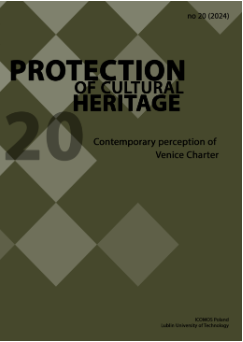PRACE KONSERWATORSKIE, A KLASYFIKACJA ZABYTKÓW
Małgorzata Korpała
Instytut Architektury i Urbanistyki, Państwowa Wyższa Szkoła Zawodowa w Nysie (Polska)
https://orcid.org/0000-0002-7784-7264
Abstrakt
Value assessment of historic monuments and sites and their classification are affected by conservation works and the impact they exert on elements of historical significance. Whether a historic monument or site can be still considered evidence of a past epoch depends on the scope of conservation works carried out in this asset. Works conducted in appropriate manner provide new information about the past. Additionally, a historic monument or site is attributed new values - not only aesthetic and functional but also the historical ones. This allows for changing their classification. Therefore, the role that the results of conservation works play in classification of historic monuments and sites has been particularly emphasised. The author of this article ponders upon whether layers of the previously carried out conservation works as well as their effects can be the reason for redoing value assessment and re-classifying a historic monument or site. These deliberations provided a basis for drawing conclusions and producing recommendations pertaining to the influence that conservation works and layers created as their result exert on the actions taken by historic preservation offices supervising these works. For this reason, the present classification should include the following:
– increasing the importance of historic monuments and sites which have not been transformed at all or have been slightly modified This concerns historic monuments and sites which are typical of their epoch, e.g. tenement houses, palaces, industrial plants, etc.
– valuable layers and elements created in the course of conservation works, which should be preserved and, prior to issuing permits by historic preservation office and launching conservation works, assessed in terms of their values. These elements should be preserved in order to place these assets under a different class, usually of a higher rank.
Preserving elements created in the course of formerly conducted conservation works and resulting in forming multiple layers is compliant with the currently applied conservation theory, which no longer accepts purist methods as a way of preserving monuments and sites. Due to this, it is possible to preserve the evidence of conservation works and take care of historic monuments and sites in order to preserve them for future generations.
Słowa kluczowe:
Conservation works, classification of historic monuments and sitesBibliografia
Dekret Rady Regencyjnej o opiece nad zabytkami sztuki i kultury z 30 października 1918 r Dz. Praw RP 1918 Nr 16.
Google Scholar
Filipowicz P., Rola zaleceń konserwatorskich w procesie inwestycyjnym realizowanym w obiekcie zabytkowym w świetle oczekiwań projektanta i inwestora, „Kurier Konserwatorski”, 2010, nr 6.
Google Scholar
Gmiter M., Przewodnik po procesie inwestycyjnym w obiektach zabytkowych, Wrocław 2013.
Google Scholar
Korpała M., Urząd Konserwatorski a zabytek, czyli o wpływie Urzędu na przygotowanie i realizację prac kon-serwatorskich [w:] System służb konserwatorskich w Polsce, red. B. Szmygin, Lublin-Warszawa.
Google Scholar
Lewicki J., Między waloryzacją a klasyfikacją, czyli o skutecznej ochronie zabytków w Polsce [w:] Ochrona war¬tości w procesie adaptacji zabytków, red. B. Szmygin, Lublin-Warszawa 2011.
Google Scholar
Michalak A., Ginter A., Ustawa o ochronie zbytków i opiece nad zabytkami. Komentarz, wyd. Wolters Kluwer, Warszawa 2016.
Google Scholar
Michalak A., Ginter A., Ustawa o ochronie zbytków i opiece nad zabytkami. Komentarz, wyd. Wolters Kluwer, Warszawa 2016.
Google Scholar
Murzyn-Kupisz M., Dziedzictwo kulturowe a rozwój lokalny, Kraków 2012; M. Murzyn-Kupisz, Europejskie fundusze pomocowe a konserwacja i adaptacja obiektów zabytkowych. Szanse i zagrożenia [w:] Adaptacja obiektów zabytkowych do współczesnych funkcji użytkowych, red. B. Szmygin, Warszawa-Lublin 2009.
Google Scholar
Rozporządzenie prezydenta RP z 6 marca 1928 r. o opiece nad zabytka¬mi; Dz. U. 1928.
Google Scholar
Ustawa z 15 lutego 1962 r. o ochronie dóbr kultury; Dz.U. 1962.
Google Scholar
Wyrok Najwyższego Trybunału Administracyjnego Rzeczypospolitej Polskiej, l. rej. 1896/35. Wg: „Przegląd Budowlany”, R. IX, 1937, z. 5.
Google Scholar
Zalasińska K., Ochrona zabytków, Warszawa 2010.
Google Scholar
Autorzy
Małgorzata KorpałaInstytut Architektury i Urbanistyki, Państwowa Wyższa Szkoła Zawodowa w Nysie Polska
https://orcid.org/0000-0002-7784-7264
konserwatorka dzieł sztuki, absolwentka Uniwersytetu Mikołaja Kopernika w Toruniu; wykładowca
w Instytucie Architektury i Urbanistyki w Państwowej Wyższej Szkole Zawodowej w Nysie,
a także w Instytucie Historii Sztuki na Uniwersytecie Kardynała Stefana Wyszyńskiego w Warszawie
Zajmuje się pracami konserwatorskimi z zakresu malarstwa i rzeźby polichromowanej, badaniami
konserwatorskimi w zabytkach architektury, jest autorka wielu publikacji z zakresu konserwacji
i badań w zabytkach architektury.
Statystyki
Abstract views: 251PDF downloads: 158








